With great mobility, means a lack of stability.
By: Recovery Specialist Dr. Kamraan Husain
The shoulders are the most mobile joint in the body. As Athletes, more often than not, we need to focus our efforts on stabilizing the shoulder through its many ranges of motion, especially before class.
There is no fool-proof way to prevent injury, but placing emphasis on the preparatory work before class can help. Focus your efforts on improving the mind-to-muscle connection before you hit the Turf and you’ll greatly lower your risk for injury, plus improve your performance in class.
Here are my top 5 shoulder exercises (performed with or without a band) to prepare your body for a safe and effective workout on the Turf.
1). Band Pull-Apart + Circumduction
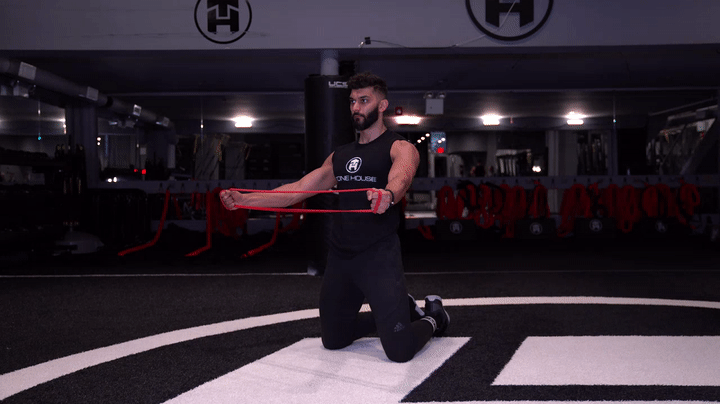
The key to this exercise is to maintain tension in the shoulder blades throughout the movement and move ONLY the arms. The best coaching cue is to try to move the arms independent of the shoulder blades (challenging your mind-muscle connection).
2). Straight Arm Pull-Down (palm forward)
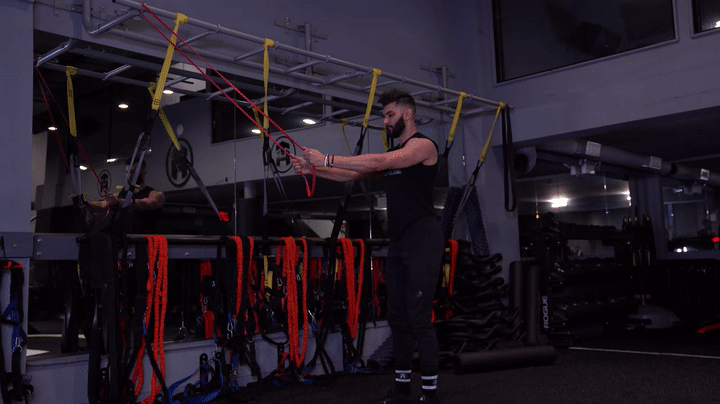
Performed with elbows at full extension and a slight hinge/bend in the hips. The key is to squeeze your arms and shoulder blades down, thus engaging the rotator cuff muscles at the end of the movement.
3). Superman
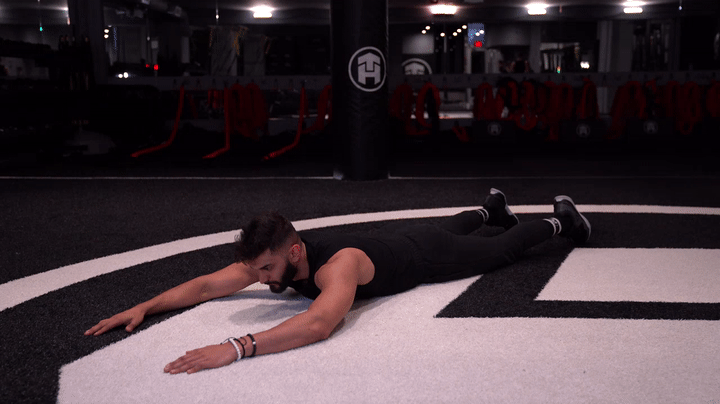
Performed lying in prone, face-down on the ground, the focus should be placed on retracting the shoulder blades and elevating the torso into extension. The best coaching cue here is to keep your feet on the ground, bring your elbows towards your butt, and squeeze the glutes as you elevate your torso.
4). Bear Crawl Shoulder Taps
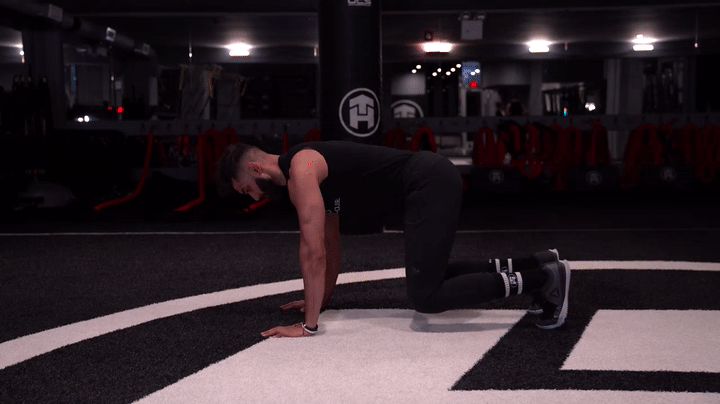
Similar to the traditional rehab exercise known as the “Bird-Dog”, this bear crawl shoulder top exercise places emphasis on slow, controlled, trunk stability. At Tone House, we spend a lot of time in bear crawl, runner, or gallop positions. It makes sense for our preparation for class to include some form of shoulder activation while also connecting the trunk and lower body.
5). Banded Scapular Retraction + Depression
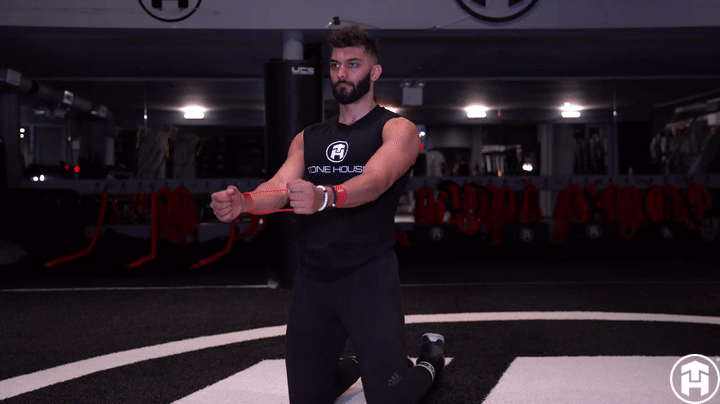
Finally, the scapular retraction and depression exercise allows us to prime our shoulders in three primary ranges of motion (extension, external rotation, and depression). The shoulder blades should be squeezed together aggressively to help improve the overall “mind-muscle” connection of the shoulders.
Each of the listed exercises should be performed to your comfort level – these are activation exercises and are not meant to completely fatigue you out before class. These exercises identify unique ways to target the shoulder musculature (in this case, the rotator cuff muscles around the shoulder blades) and will help have a positive carryover to your performance on the Turf.
Need to see Dr. Kam for a nagging pain or injury? Email him directly at doctor.kamraan@tonehouse.com.

Thanks for sharing. I read many of your blog posts, cool, your blog is very good.
Muchas gracias. ?Como puedo iniciar sesion?
Thanks for sharing. I read many of your blog posts, cool, your blog is very good.
I appreciate how well-written and informative this post is. It’s hard to find content that’s both engaging and useful—great job
Thanks for sharing such detailed information. Your blog always makes complex things so much easier to understand
Every aspect here shows high quality. From the look to the service, everything feels exclusive. You could say, this is situs toto who is truly trustworthy.
This article was truly helpfulI’ve been looking for a clear explanation like this for a while. Thank you for breaking it down so well
ada seompong hadir disini guys, gass kuy kita kulik nomer digitalstore.co.id
ada seompong hadir disini guys, gass kuy kita kulik nomer situs toto terpercaya
ada seompong hadir disini guys, gass kuy kita kulik nomer Bandar Togel
ada seompong hadir disini guys, gass kuy kita kulik nomer Bandar Togel Terpercaya
indonesia toto togel ada seompong disana ga ya indonesia toto togel
ada seompong hadir disini guys, gass kuy kita kulik nomer 4d di cfmotoindonesia.id
Can you be more specific about the content of your article? After reading it, I still have some doubts. Hope you can help me.
I savour, lead too I discovered eexactly whawt I used to
be lookig for. Yoou have ended myy 4 day lengthy hunt!
God Blews you man. Have a nice day. Bye
Baru tahu soal TOTOCC, ternyata layanannya oke banget.
Siapa di sini yang udah coba TOTOCC. Worth it nggak?
WIRO4D bikin urusan jadi lebih mudah. Keren sih.
Aku pikir biasa aja, ternyata TOTOCC profesional banget.
Layanan dari TOTOCC emang beda, detail dan niat.
Gak nyangka TOTOCC bisa secepat ini responnya. Mantap.
TOTOCC itu jawaban dari semua kebingungan saya selama ini.
Dikasih tahu temen tentang TOTOCC, eh malah ketagihan pake terus.
Kalau belum cobain TOTOCC, belum lengkap sih rasanya.
TOTOCC tuh definisi simple tapi powerful.
Hi, afcter reading thjis awesome article i aam as wel
delighged tto share mmy familiarity hdre with mates.
297050 67662Wow! Thank you! I always wanted to write on my internet site something like that. Can I include a portion of your post to my internet site? 818632
621580 730720Aw, it was a truly very good post. In concept I should put in writing related to this in addition – spending time and actual effort to manufacture a excellent article but exactly what do I say I procrastinate alot and no indicates locate a strategy to go carried out. 728628
Wiro4D emang tempat gacor buat main, WD ngebut tanpa drama
Udah coba banyak situs, tapi TOTOCC paling stabil & terpercaya
Gak nyesel gabung di TOTOCC, bonusnya banyak banget
Baru join TOTOCC, langsung hoki JP perdana! Mantap!
Main di TOTOCC, saldo cepet naik. Gaskeun bosku!
Cuma di TOTOCC yang kasih bonus harian tanpa syarat ribet!
Promo cashback TOTOCC bikin main makin aman, kalah pun dapet balik!
Top up di TOTOCC selalu ada bonus tambahan. Gila sih!
Event-event TOTOCC gak pernah zonk, selalu ada kesempatan menang besar!
TOTOCC bikin hari-hari lebih semangat dengan promo gilanya!
CS Wiro4D fast response banget, jam berapa pun dilayani!
Tampilan website Wiro4D user-friendly, enak dipakai!
Deposit & WD di Wiro4D super cepat, gak pake nunggu lama!
Game lengkap dari slot, casino, togel, semua ada di Wiro4D!
Paling nyaman main di Wiro4D, gak lemot & jarang error!
Gak usah ragu, Wiro4D udah terbukti terpercaya dari dulu!
Amanin akun kamu di Wiro4D, datanya dijaga ketat!
Proses withdraw cepet banget, gak pake ribet! Thank you wiro4d
Amanin akun kamu di Wiro4D, datanya dijaga ketat!
Udah lama main di Wiro4D, aman terus tanpa kendala.
Banyak rekomendasi teman main di sini, katanya legit. Dan emang bener!
Situs legal dan fair, Wiro4D gak main curang!
Slot PG di Wiro4D gacor banget, baru spin langsung MEGA WIN!
Game live casino di Wiro4D serasa main di kasino beneran!
Suka banget sama variasi gamenya, gak bikin bosen!
Main bareng temen di Wiro4D bikin makin seru dan kompak!
RTP tinggi banget, gak heran banyak yang betah di sini!
Masih bingung cari situs terpercaya? Coba deh Wiro4D sekarang!
Gabung sekarang di Wiro4D dan rasain sensasi gacor setiap hari!
Ayo join bareng gua di Wiro4D, kita push bareng jackpot-nya!
Kalau kamu cari cuan tambahan, Wiro4D solusinya!
Buruan daftar di Wiro4D, sebelum promo besar berakhir!
Main cuma 10k di Wiro4D, WD jutaan! Gak nyangka!
Malem-malem iseng main, eh malah WD 5x lipat modal!
Jackpot terus tiap minggu, Wiro4D memang mantap!
Serius, Wiro4D bikin mimpi jadi nyata! Cuan beneran!
Gacor parah! Main 15 menit udah bisa WD!
Komunitas Wiro4D solid banget, sering bagi tips & info gacor!
Forum Wiro4D rame, jadi tau game apa yang lagi hot!
Banyak mabar bareng member lain, makin seru mainnya di SINARCC!
Komentar-komentar dari player lain ngebantu banget di SINARCC!
Admin & membernya ramah, suasananya asik di SINARCC!
Tiap hari ada yang WD dari SINARCC! Gak ikut? Rugi banget!
Admin & membernya ramah di SINARCC, suasananya asik!
Kamu belum coba SINARCC? Rugi banget sih!
Mau tau rahasia menang besar? SINARCC jawabannya!
Banyak yang udah cuan, kamu kapan? Join SINARCC sekarang!
SINARCC = Gacor + Aman + Seru! Kombo paling top!
Ini dia situs gacor yang banyak dicari orang: SINARCC!
Wiro4D = Cuan Cepat di SINARCC!
Gacor parah bro di SINARCC! SINARCC emang beda!
Gak ribet, langsung WD! Cuma di SINARCC!